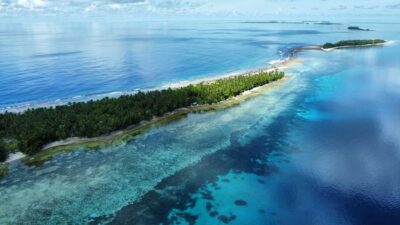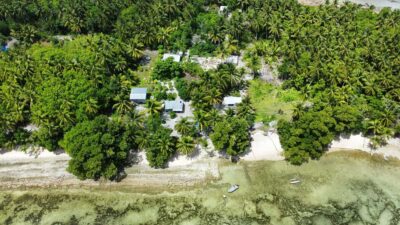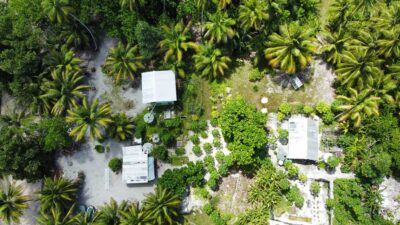Papaelise, in Tuvalu, is a tiny island perched between the Pacific Ocean and Funafuti Lagoon. It is the second islet, or motu, south of Funafuti’s main islet of Fogafale, where Tuvalu’s main settlement is. Sitting slightly under two metres above the water, it’s only about 400 metres long and 70 metres at its widest point. Despite its size and coarse, sandy and rocky soil, it has a rich ecology which its 50 or so residents utilise as well as they can – and which the Climate Resilient Islands programme is aiming to document and preserve.

The threats posed by a warming climate, rising seas, and other stresses on local atoll environments make understanding this ecology increasingly urgent. Climate Resilient Islands aims to strengthen climate resilience through nature-based solutions, with actions that benefit both local communities and the ecosystems they live amongst. Live & Learn Tuvalu has been working with the Papaelise residents to understand the local ecosystem – and how it can be protected to create a more resilient community.
The lagoon side of Papaelise is lined with the large, broadleaf fetau tree, an excellent coastal protection species which helps prevent erosion of coastal land from storm surges and sea level rise, both of which are increasingly pressing issues on Papaelise. The wood of the fetau tree is used for canoes and houses for the islet’s growing community.
Tepukavaka broadleaf trees, an important nesting site of the black noddy bird, grow down the middle of the islet. Papaelise was once named Funagogo, meaning ‘land of the noddies’. These sea birds are a popular traditional food. But in recent times, especially during the COVID-19 relocation policy, which saw people moving to Papaelise to stay safe from the virus, many of these important trees were felled to allow space for the new homes of the slowly increasing population.
The soils of this area are very dark due to the guano from the nesting birds. Settlers have taken advantage of this rich soil to make their food gardens, planting pawpaw, breadfruits, vegetables and root crops. Also around the houses are the domesticated pandanus variety, grown for its sweet pulp.

Other areas are not flourishing as well. An abandoned pulaka pit – a low-lying area used to grow one of Tuvalu’s most treasured traditional foods – lies in the south of the islet, around the remain of an abandoned well. Sea water intrusion has contaminated the island’s freshwater, making the well unusable, while the surroundings of this low area have also been badly eroded leaving behind barren rocks. Only salt bush, te gasu, does well in these harsh conditions.
However, the higher ground around this low-lying area offers greener vegetation, including bird nest ferns. The tips of their young leaves are very popular with Tuvaluans, who cook them like cabbages and eat them raw like lettuce. The coconut palm – the symbol chosen to represent Papaelise’s resilience – is their most dominant plant species. It can be found all over the island, even on rocky areas, providing food and craft materials.
But although the people of Papaelise know how they can use the resources available to them, environmental conditions are changing. Salt spray is common and is worse when there is a strong trade wind blowing from the east, which now occurs more regularly, along with rough seas, according to the islanders. There are also challenges with rain. This is their only fresh water source, but rainfall events are getting heavier with longer dry periods in between, affecting the soil and availability of drinking water, while the storms create stress for crops and trees. Agricultural land is also more regularly inundated by king tides.
Sea level rise and these harsh weather events are slowly taking away important trees and vegetation along the coast that protect from further land erosion, leaving food gardens, vegetation, livestock and infrastructure vulnerable to the devastating effects of cyclones.
But Papaelise’s people are already adapting to these changing conditions. Life can be difficult on an atoll, but it can also be rich in many ways. The local community understands the richness of their ecology, and how to preserve it, well; through the Climate Resilient Islands programme, they will be able to care for it so that the people and these ecosystems can be strengthened.

Live & Learn thanks the people of Papaelise for their support and contribution to the CRI programme. We greatly appreciate your time and input.
Climate Resilient Islands is a New Zealand Ministry of Foreign Affairs and Trade initiative, implemented by Live & Learn Environmental Education, with funding provided by the New Zealand Government.
